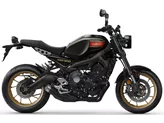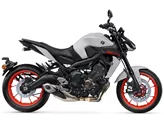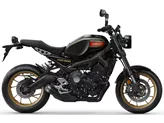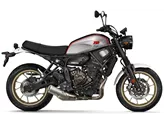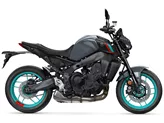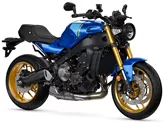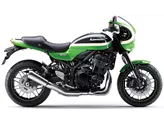Suzuki GSR 750 2013 vs. Yamaha XSR900 2016

Suzuki GSR 750 2013

Yamaha XSR900 2016
Genel bakış - Suzuki GSR 750 2013 vs Yamaha XSR900 2016
The Suzuki GSR 750 2013 and the Yamaha XSR900 2016 are both naked bikes with similar engine types and power outputs. The Suzuki GSR 750 has an in-line engine with 106 HP, while the Yamaha XSR900 has an in-line engine with 115 HP. This means that the Yamaha XSR900 has a slightly more powerful engine compared to the Suzuki GSR 750.
In terms of torque, the Suzuki GSR 750 has 80 Nm, while the Yamaha XSR900 has 87.5 Nm. Again, the Yamaha XSR900 has a slightly higher torque output compared to the Suzuki GSR 750. Both bikes have 4 cylinders and similar displacements, with the Suzuki GSR 750 having a displacement of 749 ccm and the Yamaha XSR900 having a displacement of 847 ccm.
In terms of chassis, the Suzuki GSR 750 has a steel frame, while the Yamaha XSR900 has an aluminum frame. The frame type for both bikes is twin tube. This means that the Yamaha XSR900 has a lighter frame compared to the Suzuki GSR 750, which could contribute to better handling and maneuverability.

Suzuki GSR 750 2013
Both bikes have double disk brakes at the front, providing good stopping power. The front and rear tire widths and diameters are the same for both bikes, with a width of 120 mm and a diameter of 17 inches. This ensures stability and grip while riding.
The wheelbase for the Suzuki GSR 750 is slightly longer at 1450 mm compared to the Yamaha XSR900's 1440 mm. The seat height for both bikes is the same at 815 mm. The kerb weight of the Suzuki GSR 750 is 211 kg, while the Yamaha XSR900 is lighter at 188 kg. This means that the Yamaha XSR900 is lighter and potentially more agile compared to the Suzuki GSR 750.
In terms of fuel tank capacity, the Suzuki GSR 750 has a larger capacity at 17.5 l compared to the Yamaha XSR900's 14 l. This means that the Suzuki GSR 750 has a longer range before needing to refuel.

Yamaha XSR900 2016
Looking at the strengths of the Suzuki GSR 750, it has good ergonomics, a powerful engine, ABS, and easy-to-read instruments. On the other hand, the Yamaha XSR900 has a greedy engine, well-tuned riding modes, ABS and TC as standard, an authentic modern design, and clean workmanship.
In terms of weaknesses, the Suzuki GSR 750 has weak brakes, a cheap-looking square swingarm, and suspension elements without adjustability. The Yamaha XSR900 has a hard chassis, a seat that could be more comfortable, and a speedblock design that is already present on many other models.
In conclusion, while both the Suzuki GSR 750 2013 and the Yamaha XSR900 2016 are naked bikes with similar specifications, the Yamaha XSR900 offers a slightly more powerful engine, a lighter frame, and better standard features such as ABS and TC. However, the Suzuki GSR 750 has a larger fuel tank capacity and potentially better ergonomics. Ultimately, the choice between the two will depend on the rider's preferences and priorities.
Teknik Özellikler Suzuki GSR 750 2013 ile karşılaştırıldığında Yamaha XSR900 2016
Karşılaştırıldığında Artıları ve eksileri
Karşılaştırıldığında Artıları ve eksileri
Suzuki GSR 750 2013

Ayar seçeneklerinin olmamasi nedeniyle, sasi iyi bir uzlasmadir.
Yamaha XSR900 2016

XSR900, sportif bir streetfighter'in performansini hos, temiz bir sekilde tamamlanmis retro bir naked motosikletin görünümüyle birlestiriyor. Japon sirket bunu yaparken, 60 yildir Yamaha için çalisan tasarim ajansinin arsivlerinde bulunabilecek kendi geçmisinden yararlaniyor. MT-09'un erdemlerini benimsemis ve bazi zayifliklarini iyilestirmistir. Daha uyumlu, daha kontrollü ve istenirse daha rahat bir sürüs sagliyor. Kötü yollarda gergin sasiden sadece konfor ve dolayisiyla sürücü zarar görüyor. Bir neo-klasik ile biraz aci çekebilmeniz gerekir.
Fiyat Karşılaştırması Ortalama Piyasa Fiyatı Suzuki GSR 750 vs Yamaha XSR900
There are a few key differences between a Suzuki GSR 750 2013 and a Yamaha XSR900 2016. In terms of price, the actual average price of a Yamaha XSR900 2016 is about 10% higher. A Suzuki GSR 750 2013 experiences a loss of 800 USD in one year and 920 USD in two years of ownership. This is offset by a loss of 1,650 USD and 1,670 USD for a Yamaha XSR900 2016. Compared to Yamaha XSR900 2016 there are more Suzuki GSR 750 2013 bikes available on the 1000PS.de Marketplace, specifically 10 compared to 5. It takes less time to sell a Suzuki GSR 750 with 58 days compared to 77 days for a Yamaha XSR900. Since model year 2011 1000PS.de editors have written 12 reviews for the Suzuki GSR 750 and 30 reviews for the Yamaha XSR900 since model year 2016. The first review for the Suzuki GSR 750 was published on 10/5/2010 and now has more than 5,400 views. This compares to more than 17,600 views for the first review on Yamaha XSR900 published on 11/25/2015.



